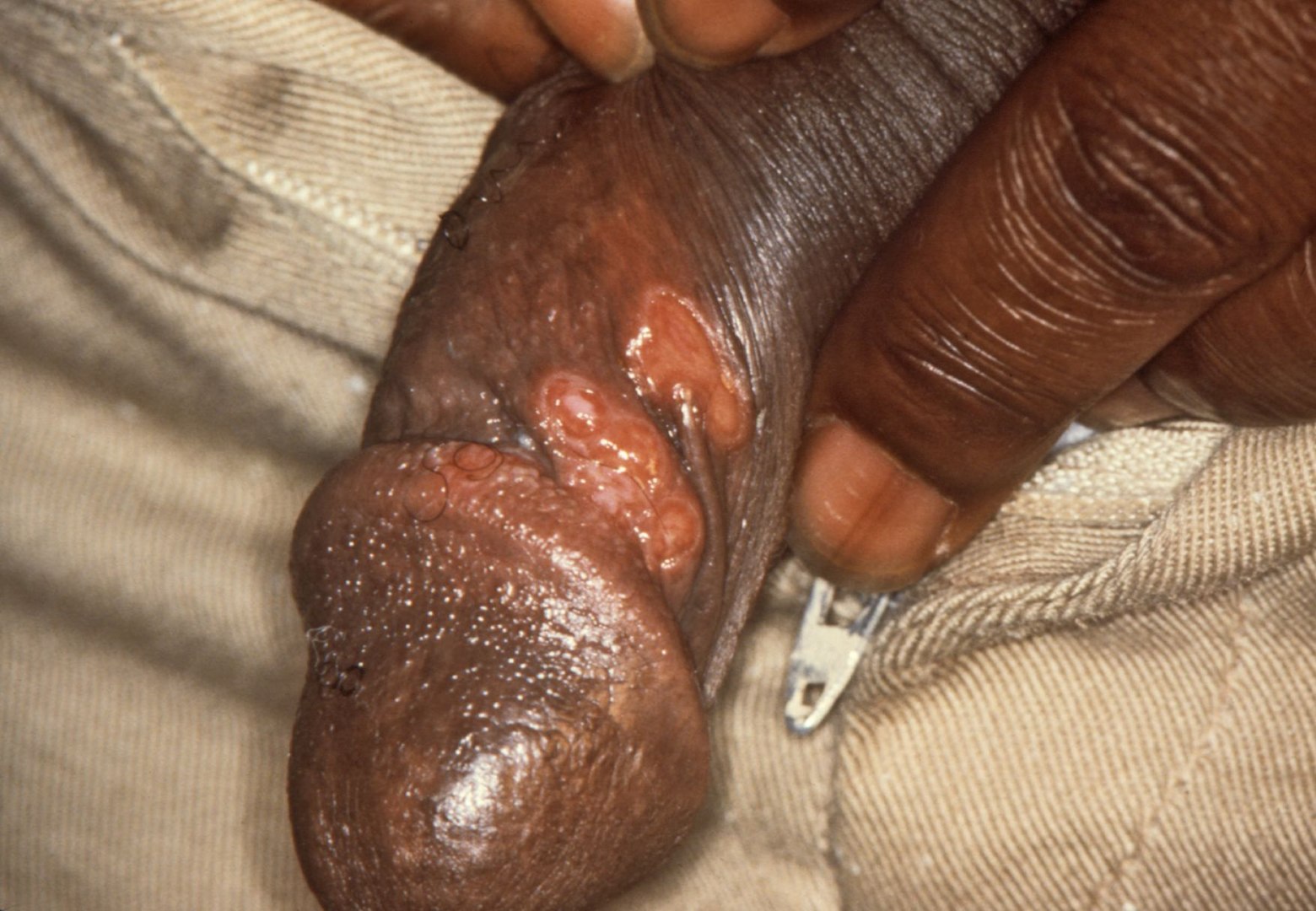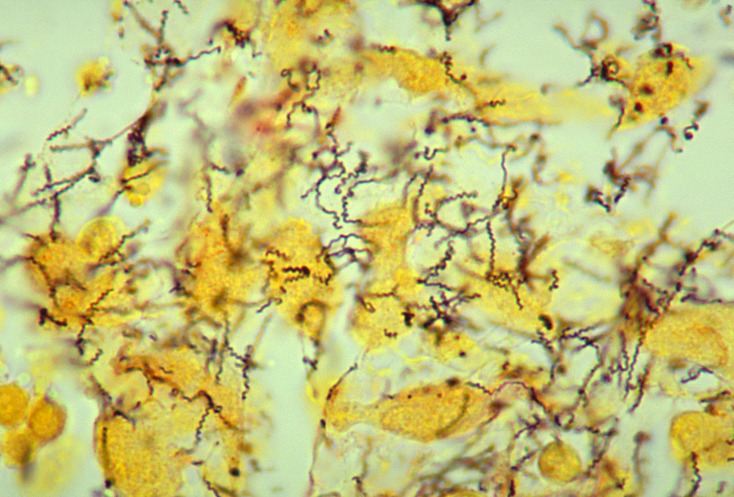Playlist
Show Playlist
Hide Playlist
Treponema
00:01 Treponema, a bacteria. 00:03 Treponema are spirochetes. 00:06 They are probably one of shorter, smaller, harder to see spirochetes certainly when compared to the Borrelia another classic form or example of a spirochete infection. 00:18 The spirochetes of Treponema also possess three axial filaments which are integral to their structure. 00:25 They do not culture well or at all in-vitro and they are very difficult to see in gram stain. 00:31 The organisms are too thin, too translucent, too pale which actually brings to mind one of the specific types of Treponema we’ll talk about. 00:40 What are the human pathogens? Treponema pallidum, the pale organism, the pale Treponema and you can see an example on the image of a spirochete, a curly cue infection which can only be seen with specific staining techniques. 00:57 Treponema pallidum is the cause of syphilis and we’ll spend a fair amount of time in this session talking about that specific organism and that infection. 01:07 There are two other human pathogens that we’ll discuss. 01:10 The first is the Treponema pallidum pertenue, the cause of Yaws, and Treponema carateum, the cause of Pinta, both of those will deserve at least one or two slides just to familiarize yourself with the infections caused by them. 01:27 Go, let’s start first with how to identify? How to look for the Treponema? Again, because they're very difficult to see by normal methods such as like microscopy. 01:37 Instead we turn to something called dark field microscopy, inverting the image so that what little tissue’s present actually appears dark and you can see an example of that in the top image on the slide. 01:50 Another mechanism is to use fluorescence microscopy to target or label the Treponema itself with fluorescent labeled antibodies which then can be stained and shown under fluorescent light and you see an example of that in the lower image. 02:07 Chromogenic immunohistochemical staining on biopsy tissue using antibody against treponema pallidum. Looking then at tests for the Treponema, and these are fairly specific to Treponema pallidum, there are two different categories that we look at, the non-Treponemal tests and the Treponemal tests. 02:27 Non-Treponemal basically means a test which picks up the suggestion of an infection by Treponema but it's not unique to that specific infection thus other types of illnesses can precipitate a positive reaction. 02:44 Treponemal tests are specific or unique to the Treponema and those typically are immunoglobulin G based, so they’d persist. 02:53 Then looking at the specificity, for nontreponemal tests they're nonspecific for Treponemal associated damage and in fact are cause by release of cardiolipin into the system in the blood and yet the nontreponemal tests react to that. 03:12 Why do we look for cardiolipin? Because that is one of the targets which is released by the pathogenesis of syphilis although other things can do that. 03:21 The Treponemal tests are specific for antibody released only by the Treponemal antigen, again, immunoglobulin G based which persists for a long time. 03:31 Looking at the types of tests, nontreponemal tests classically are the VDRL standing for Venereal Disease Research Laboratories test, if you wish to remember that although most people just say VDRL and the RPR test the most common screening test we use for syphilis and that stands for Rapid Plasma Reagin test. Specific types for the Treponemal tests are the FTA absorb or FTA-ABS tests standing for fluorescent treponemal antibody absorption test, and the MHA-TP, microhemagglutination test for Treponema pallidum. 04:12 Basically the initials say it all and they will describe what those are. 04:16 The easy thing to remember is an RPR or a VDRL is nonspecific—a nontreponemal test the others are all specific to antigens from the Treponema organism itself. 04:29 Now, looking at the effect of treatment on both of those types of tests; in the nontreponemal test the RPR or the VDRL, one can see a decrease in titer because as we treat the infection related to Treponema pallidum, as we treat the syphilis, the tissue inflammation that the reaction to that infection wanes, it decreases and thus the amount of cardiolipin released into the systemic circulation can decrease and decreases the positivity of the test. 05:02 However, a Treponemal test because it is immunoglobulin G based, once it is developed, it remains positive for either the life of the human or for a very long time. 05:13 So why do we even have two different types of tests? Well, in fact the nontreponemal tests are used for screening and monitoring because they are rapidly and easily able to be performed. 05:28 In fact, they can be performed at most medical centers, most hospitals. 05:34 The treponemal tests which are used to confirm the infection take longer to take, they're more sensitive, they are more specific, but they take longer to actually use in the clinical setting. 05:46 Very importantly, there are a whole range of reasons to create false positive results for both the non-treponemal and the treponemal tests. Looking first to the non-treponemal test. 05:59 Some of the most common causes of a false positive result are those patients who are pregnant, and indeed, the state of pregnancy can induce false positivity for both types. 06:10 Also, those patients who have a collagen-vascular disease such as lupus, those patients with leprosy, another type of infection. 06:20 Those patient with recent immunization or even recent viral infections. 06:25 So there are a whole host of reasons for a false positive, RPR or VDRL non-Treponemal test. 06:33 For the Treponemal tests, although those are immunoglobulin G based, they may also be falsely elevated by other diseases which have molecular mimicry which raise the antibody to something similar to the antigen on the Treponemal cell wall. 06:50 Those again could be things like pregnancy that could indeed be rheumatoid arthritis. 06:55 Lupus, again, it’s a possibility so too are some other sexually transmitted infections such as herpes and even some fungal infections the mycoses. 07:06 You can see the complete list for both of these, the important ones to remember are the state of pregnancy and lupus as these are commonly asked on certain standardized exams. 07:18 Now, let’s look at the pathogenesis of Treponema pallidum. 07:22 The first step is for the spirochete, the organism to adhere to a skin or mucosal membrane. 07:29 It then produces hyaluronidase and allow for tissue invasion. 07:34 Spirochetes uniformly need some sort of mechanism to burrow into their target tissue and in this case is due to the enzyme action to open up a pathway. 07:44 Then as the Treponema is coated, excuse me, as it's burrowing into the host membrane it is coating itself with fibronectin coming from the host, you might think of this as a sort of a wolf in sheep’s clothing, it's coating itself with the human body to avoid immune recognition which then prevents phagocytosis and an immunologic reaction. In this way it can spread widely into the bloodstream and create a widespread infection even before signs or symptoms of disease develop, it’s quite smart that way. 08:19 Ultimately a host immune response does occur and that is when the patient develops specific disease manifestations.
About the Lecture
The lecture Treponema by Sean Elliott, MD is from the course Bacteria.
Included Quiz Questions
Which sexually transmitted disease is caused by Treponema pallidum?
- Syphilis
- Gonorrhea
- Chlamydia
- Herpes
- Genital warts
Treponemal tests are based on which type of immunoglobulin?
- IgG
- IgA
- IgM
- IgE
- IgD
Which is the most common screening test used for syphilis?
- RPR test
- FTA-ABS test
- VDRL test
- MHA-TP test
- Stool antigen test
In addition to treponemal infections, treponemal and nontreponemal test results can be positive in which one of the following conditions?
- Pregnancy
- Gastrinoma
- Cirrhosis
- Crohn's disease
- Ulcerative colitis
Customer reviews
5,0 of 5 stars
| 5 Stars |
|
5 |
| 4 Stars |
|
0 |
| 3 Stars |
|
0 |
| 2 Stars |
|
0 |
| 1 Star |
|
0 |





